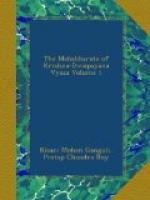4. A gift. It may be of various kinds. The fees paid to Brahmanas assisting at sacrifices and religious rites, such as offering oblations to the dead, are Dakshinas, as also gifts to Brahmanas on other occasions particularly when they are fed, it bring to this day the custom never to feed a Brahmana without paying him a pecuniary fee. There can be no sacrifice, no religious rite, without Dakshina.
5. Reference to self, i.e. without the motive of bettering one’s own self, or without any motive at all. (This contains the germ of the doctrine preached more elaborately in the Bhagavad gita).
6. This Yoga consists, in their case, of a combination of attributes by negation of the contrary ones, i.e. by renunciation of motives in all they do.
7. A form of Yoga that is said to consist in the mingling of some of the air supposed to exist in every animal body. These airs are five: Prana, Apana, Samana, Udana, and Vyana.
8. The 8 Vasus, the 11 Rudras, the 12 Adityas, Prajapati, and Vashatkara.
9. An order of celestials.
10. Celestial flowers of much fragrance.
11. The ascetic properties are Anima, Laghima, etc.
12. The bow of Vishnu, as that of Siva is called Pinaka.
13. The words of the text are Adhana, Pashubandha, Ishti Mantra, Yajana and Tapa-kriya.
14. Dhritarashtra being blind is described as Pragnachakshu, i.e. having knowledge for his eye. It may also mean. “Of the prophetic eye.”
15. The great preceptor of the Asuras, viz., Sukra, possessing the highest intelligence as evidenced by his various works on all manner of subjects particularly, the Sukra-niti.
16. Also called Vadarika, a hermitage on the Himalaya near the sources of the Ganges.
17. Nilakantha explains kshetra as including Mahabhuta, consciousness, intellect, the unmanifest (primordial elements), the ten senses, the five objects of the senses, viz., earth, water, &c., desire, aversion, pleasure, pain, the combinations of elements, and chaitanya.
18. Hari here means the developed seed that is to expand into the vast whole of the universe.
19. This wheel is the wheel of Time—i.e., measured according to the solar, lunar and astral revolutions. The importance of Ashtavakra’s reply is this: May the meritorious deeds performed at proper times, during the revolution of this wheel of Time protect thee.
20. Thunder and lightning or misery and death.
21. Cloud or the mind.
22. The male being that is ever conscious.
23. The mundane egg.
24. The soul that has renounced connection with the body.
25. The heart of a Yogi.
26. Ashtavakra comes to Janaka’s sacrifice with the object of proving the unity of the Supreme Being. Vandin avails himself of various system of Philosophy to combat his opponent. He begins with the Buddhistic system. The form of the dialogue is unique in literature being that of enigmas and the latent meaning is in a queer way hid under the appearance of puerile and heterogeneous combinations of things.




